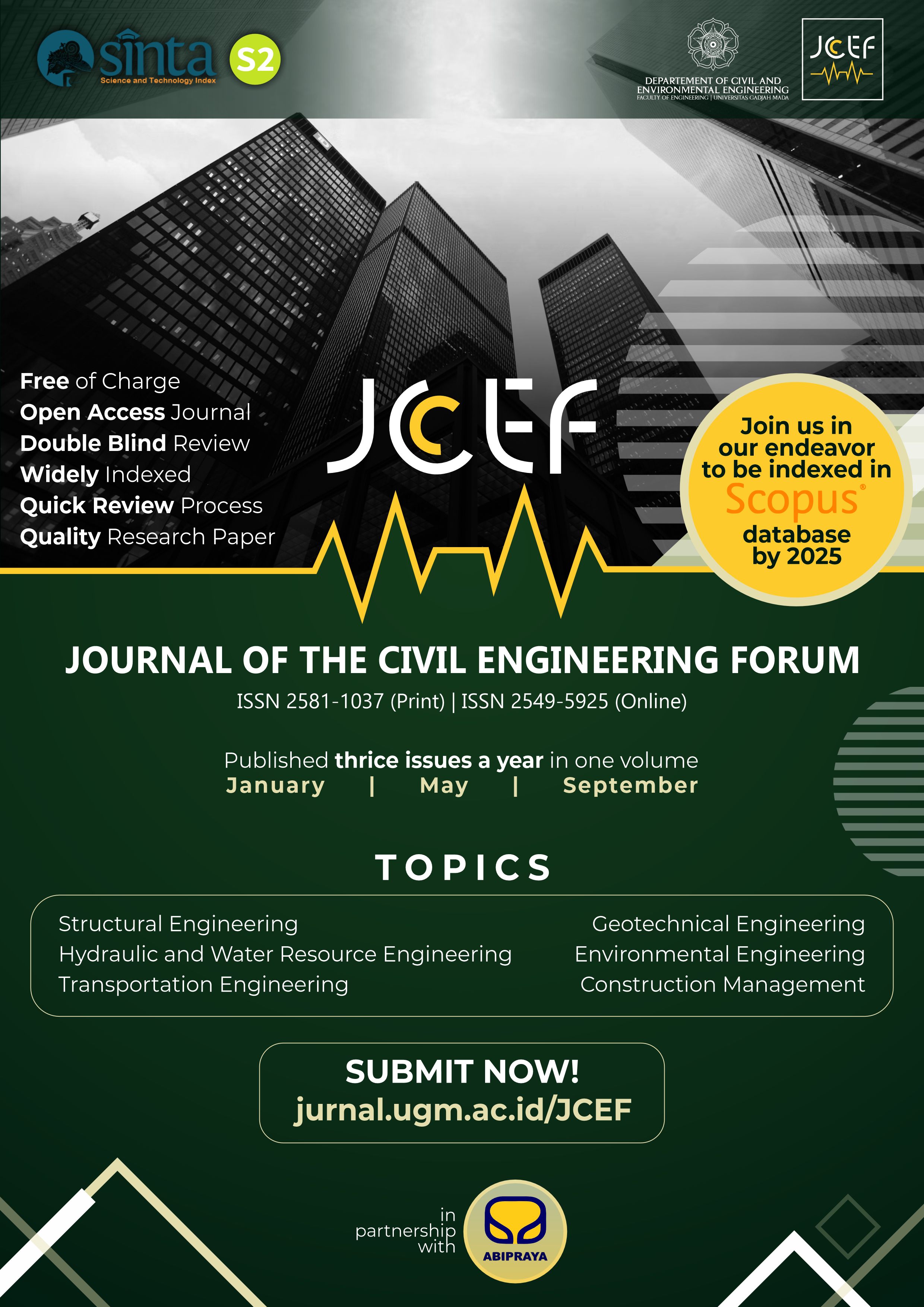The Analysis of Beam-Column Joint Reinforced with Cross Bars according to SK SNI T-15-1991-03 on Cyclic Loads
Abstract
The primary structural component supporting the other structural loads in a building is the beam-column joint. It is considered a critical area of a building which needs to be accurately designed to ensure energy is dissipated properly during the occurrence of an earthquake. Beam-column joint has the ability to offer a proper structure required to transform cyclic loads in the inelastic region but also has a direct impact on the components connected to it during the occurrence of any failure. This is one of the reasons the beam-column connection needs to be designed carefully. Therefore, this study focused on designing a beam-column joint with reinforcement according to SK SNI T-15-1991 in order to withstand cyclic loads. The test specimen used was observed to have a concrete compressive strength of 19.17 MPa while the dimension of the beam was 120 x 30 x 40 cm and the column was 30 x 30 x 200 cm, having 8Ø13.4 mm bars with 310.03 MPa yield strength (fy) as well as Ø9.8-100 mm stirrup reinforcement with (fy) 374.59 MPa. The test was initiated through the provision of 0.75 mm, 1.5 mm, 3 mm, 6 mm, 12 mm, 24 mm monotonic cyclic loads at the end of the beam up to the moment the specimen cracked. A maximum load of 68.35 kN for the compression and 49.92 kN for the tension was required to attain the cyclic load capacity. The maximum load was attained at 50.98 mm displacement. Furthermore, beam-column with 23.93 mm displacement caused a reduction in capacity. Meanwhile, the load at 24 mm produced the cycle's highest dissipation energy of 13.25 but this can be increased through the addition of stirrups to provide stiffness in the joint. The stiffness value was also observed to have increased after the structural repairs.
References
Abdullah & Takiguchi, K., 2003. An Investigation Into The Behavior and Strength of Reinforced Concrete Columns Strengthened With Ferrocement Jackets. Cement and Concrete Composites, 25, pp. 233-242.
Departemen Pekerjaan Umum RI, 1991. Standar SK SNI T-15-1991-03, Tata Cara Penghitungan Struktur Beton untuk Bangunan Gedung. Bandung: LPMB Departemen Pekerjaan Umum RI.
Elghazouli, A.Y., 2017. Seismic design of buildings to Eurocode 8. Boca Raton: CRC Press/Taylor & Francis Group.
Elmasry, M.I., Abdelkader, A.M., & Elkordy, E.A., 2017. An Analytical Study of Improving Beam-Column Joints Behavior Under Earthquakes, South Sinai: GeoMEast 2017.
Raghucharan, M. & Prasad, D., 2015. How to Make Concrete More Ductile - A State of Art, International Journal of Engineering and Technical Study (IJETR), 3(5), 2321-0869.
Rodrigues, H., Varum, H., & Costa, A., 2010. Simplifed Macro-Model for Infll Masonry Panels, Journal Earthquake Engineering, 14(3), pp. 390–416.
Schodek, D.L., 1998. Struktur. Terjemahan Bambang Suryoatmono. Bandung: Refika Aditama.
Soebandono, B., Triwiyono, A., & Muslikh, 2011. Perbaikan Balok Beton Bertulang dengan Metode Jacketing dengan Bahan Ferosemen Akibat Beban Siklik pada Beban Ultimit, Jurnal Ilmiah Semesta, 1(2), pp. 166-176.
Sudha, Kuncham & Sadiku, Rotimi & Jayaramudu, Tippabattini & K.Sudhakar, & Moropeng, Mapula, 2015. Chapter-16 “Mechanism of toughening in nanostructured polymer blends. 10.1016/B978-0-323-39408-6.00015-7.
Venkatesan, B. & Ilangovan, R., 2016. Structural Behaviour of Beam Column Joint Retrofitted with Ferrocement Laminates, International Journal of Advanced Engineering Technology, VII, pp.1272-1280.
Wang, C. K. & Salmon, C.G., 1991. Desain Beton Bertulang. Jilid I, Jakarta : Erlangga.
Copyright (c) 2021 The Author(s)

This work is licensed under a Creative Commons Attribution-ShareAlike 4.0 International License.
Copyright is granted to authors for the purpose of providing protection for articles written to describe experiments and their results. JCEF will protect and defend the work and reputation of the author and are also willing to address any allegations of violation, plagiarism, fraud, etc. against articles written and published by JCEF. JCEF is published under the terms of the Creative Commons Attribution-ShareAlike 4.0 International License (CC BY-SA 4.0). The author holds the copyright and assigns the journal rights to the first publication (online and print) of the work simultaneously.




